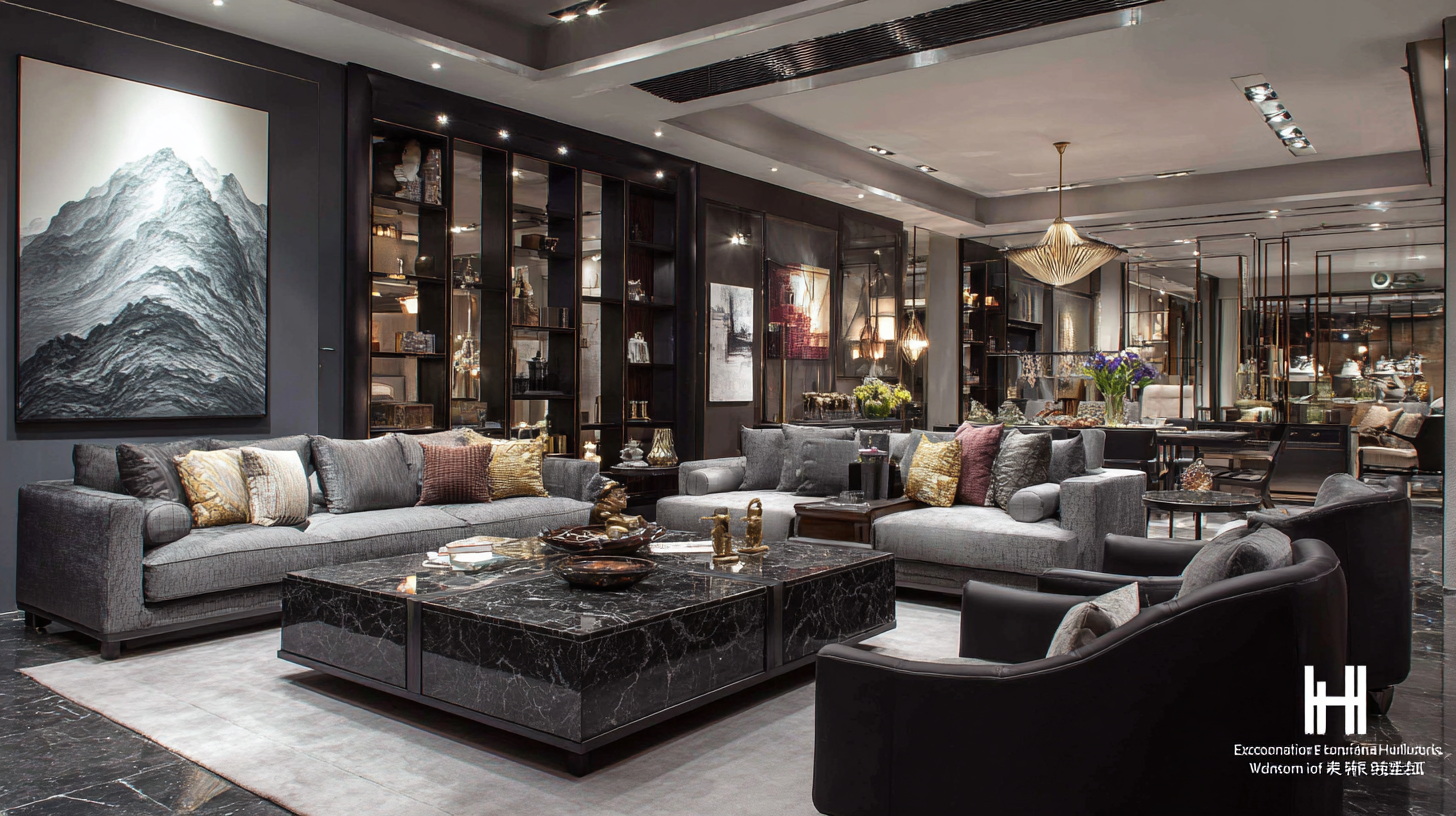Exceptional Manufacturing from China Delivering Superior Showroom Furniture Worldwide
In the highly competitive world of retail, the significance of showroom furniture cannot be overstated. According to a report by Grand View Research, the global furniture market size reached USD 545.78 billion in 2021 and is projected to expand at a compound annual growth rate (CAGR) of 5.2% from 2022 to 2030. This surge in demand highlights the critical role that well-designed and functional showroom furniture plays in enhancing customer experience and driving sales. China has emerged as a powerhouse in manufacturing, leveraging advanced technologies and efficient supply chains to produce high-quality showroom furniture that meets international standards. As businesses seek to elevate their branding and create immersive shopping environments, understanding the unique benefits of sourcing showroom furniture from China becomes essential. This ultimate guide will explore the exceptional manufacturing capabilities from China, shedding light on how they deliver superior showroom furniture worldwide, ultimately transforming retail spaces into compelling destinations for consumers.

Exceptional Quality: The Hallmark of Chinese Showroom Furniture Manufacturing
The allure of showroom furniture from China lies in its exceptional quality, which has become the hallmark of the industry. Chinese manufacturers are renowned for their impeccable craftsmanship, making use of innovative techniques and materials that elevate the standard of furniture design. Each piece is meticulously crafted to not only meet but exceed the expectations of discerning consumers, showcasing a unique aesthetic that appeals to modern tastes. This commitment to quality and design has positioned Chinese furniture as a top choice for those looking to transform their spaces with sophistication.
In contrast, as discussions around local manufacturing intensify, the question arises: what can British-made beds offer in this competitive landscape? While British manufacturing is often synonymous with heritage and durability, comparing this with the alluring designs and quality from China requires a deeper understanding of consumer values. As Brexit influences spending habits, consumers are increasingly selective, assessing the intrinsic value of domestically produced goods against their imported counterparts. The emotional connection to homegrown products remains strong, yet the global market showcases that exceptional quality and innovative designs can also be found beyond national borders, compelling consumers to weigh both options effectively.
Exceptional Manufacturing from China Delivering Superior Showroom Furniture Worldwide
| Furniture Type | Material | Dimensions (cm) | Weight (kg) | Finish Options |
|---|---|---|---|---|
| Display Cabinet | Wood & Glass | 80 x 40 x 180 | 60 | Glossy, Matte |
| Storage Shelf | Metal & Wood | 120 x 30 x 200 | 50 | Powder Coated, Natural |
| Coffee Table | Glass & Metal | 100 x 60 x 40 | 25 | Translucent, Frosted |
| Dining Chair | Wood | 45 x 50 x 90 | 7 | Varnished, Painted |
| Showroom Desk | MDF & Laminate | 150 x 75 x 75 | 30 | Wood Grain, Solid Color |
Innovative Design Trends Shaping the Future of Furniture in Global Markets
The global furniture market is witnessing a transformative wave, driven by innovative design trends that redefine both aesthetics and functionality. Manufacturers in China are leading this charge, leveraging advanced technologies and sustainable materials to create exceptional showroom furniture that meets the diverse needs of consumers worldwide. As more designers embrace modular and adaptable pieces, furniture is evolving beyond mere utility to become a vital part of interior narratives.
One of the most significant trends shaping the future of furniture design is the integration of smart technology. From built-in charging stations to responsive lighting, modern furniture is becoming increasingly intuitive, responding seamlessly to the lifestyles of contemporary users. Moreover, a growing emphasis on sustainability is prompting designers to explore eco-friendly materials and production methods, ensuring that style does not come at the cost of environmental responsibility.
As these innovative design trends continue to develop, they not only influence consumer preferences but also reshape the global furniture landscape, showcasing the vital role of creative vision in manufacturing.
Sustainable Practices in Chinese Furniture Production: A Global Responsibility
Sustainable practices in furniture production have become a global responsibility, especially for manufacturers in China who are increasingly aligning with international standards. A recent survey indicates that consumers are willing to pay a premium of 9.7% for sustainably produced goods, reflecting a profound shift in purchasing behavior amidst rising cost-of-living and inflationary concerns. This trend is not just a temporary response but a clear indication of the growing awareness and demand for sustainability in consumer choices.
In the context of the furniture industry, companies are adopting circular economy principles to minimize waste and extend product lifecycles. By evaluating their production processes through life cycle analysis, manufacturers can identify areas for improvement and strategically implement sustainable practices. For instance, the green divide between Chinese and Western consumers showcases a shared recognition of sustainability's importance, even amid differing approaches to environmental responsibility.
Tips for Consumers:
- Seek out brands that transparently share their sustainability practices and sources.
- Consider investing in furniture that prioritizes recyclable materials and reduced carbon footprints, as this not only benefits the environment but also supports long-term cost savings.
- Embrace circular economy initiatives, such as buying used or refurbished furniture, to contribute to sustainability efforts and reduce landfill waste.
Logistics and Export Strategies: How China Reaches Showrooms Worldwide
China has cemented its position as a global leader in the manufacturing sector, particularly in the furniture industry. With a staggering reported export value of over $90 billion in 2022, Chinese manufacturers are increasingly adept at optimizing their logistics and export strategies to reach showrooms worldwide. Advanced supply chain management technologies and strategic partnerships with shipping companies have enabled manufacturers to streamline operations and reduce costs, ensuring that high-quality showroom furniture can be both affordable and readily available across different markets.
The use of data analytics and AI-driven insights plays a pivotal role in enhancing the logistics process. According to a report by the China National Furniture Association, companies that leverage these technologies can improve delivery times by up to 30%, significantly impacting customer satisfaction. Additionally, the implementation of integrated logistics solutions has enhanced the tracking and management of shipments, allowing for real-time updates for overseas clients. As a result, furniture showrooms around the world benefit from quick, reliable delivery, setting the stage for a seamless retail experience that meets the growing demand for quality Chinese-made products.

Case Studies: Success Stories of Chinese Manufacturers in the International Arena
In recent years, Chinese manufacturers have made significant strides in the international market, showcasing their innovative capabilities through remarkable case studies. The "China Enterprises Overseas Communication Strength Analysis Report (2022)" highlights key factors driving the global presence of Chinese brands. For instance, leading companies have successfully transitioned from OEM (Original Equipment Manufacturer) to global custom solutions, reflecting a deep understanding of international consumer needs. This transformation is crucial for enabling them to narrate their growth stories on a larger platform, which is vital in building brand trust globally.

Tips for manufacturers looking to expand internationally: First, invest in understanding emerging market trends and consumer behaviors to tailor products effectively. Second, showcase your brand story and innovation through various channels, leveraging digital platforms to reach a wider audience. Lastly, focus on quality and sustainability, as these values resonate with today's conscious consumers. The success stories of companies that embraced change and innovation are now being studied within global business classrooms, highlighting the importance of adaptability in the ever-evolving marketplace.
